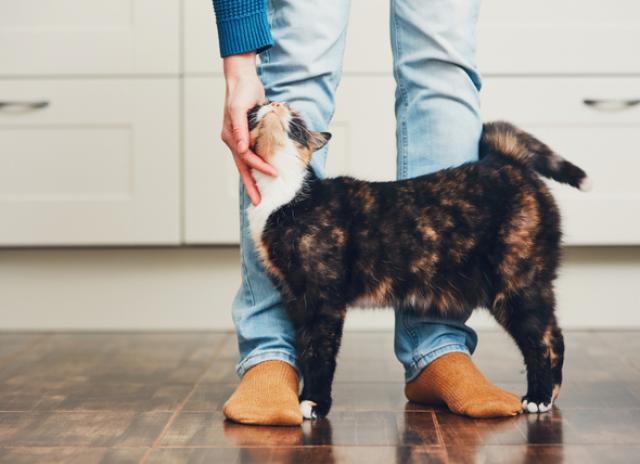8 Surprising Ways to Say “I Love You” in Cat Language

Reviewed and updated for accuracy on June 15, 2018, by Katie Grzyb, DVM.
Most cat lovers don’t need to be told that a steady supply of cuddles and cat treats will keep their feline friends happy. But what are some methods to show your cat signs of affection that go a little deeper? By learning more about innate cat behavior, you can enhance the bond you share. Here are eight fun ways to show your cat love—in cat language.
1. Gaze Softly Into Your Cat’s Eyes
Did you know that you can show your cat affection simply by looking at her? It just takes some finesse. “When you look at your cat, always use a soft gaze and never a hard stare,” says Pam Johnson-Bennet, CCBC, and best-selling author of “CatWise.” “In the animal world, a direct stare is viewed as a threat.”
“If you really want to amp up the affection factor,” Johnson-Bennett adds, “offer a slow eye blink as well.” In cat language, blinking slowly signals that you’re relaxed and mean no harm. If your cat feels the love, too, she might blink back. “This is commonly referred to as a cat kiss,” Johnson-Bennett says.
2. Respect Petting Preferences
Has your cat ever come to you for cuddles, only to wriggle out of your arms seconds later? If so, you may need to modify your petting style. “The cat’s body is very sensitive, and when you stroke certain areas, you want to get a positive reaction and not a defensive one,” Johnson-Bennett says. For instance, some cats enjoy a good chin-scratching, but others prefer long strokes from head to toe. “Observe how your cat reacts when you stroke various areas of the body so you’ll know what creates a calm, enjoyable reaction,” says Johnson-Bennett.
And while many cat lovers could probably pet kitties for hours on end, it’s important to know when to stop. “You always want to end the session on a positive note,” Johnson-Bennett says, “so watch for signals that kitty is getting tired of the physical contact.” Learning how your cat communicates with their body can help you figure out when your cat is ready for their petting session to end.
3. Enrich Your Cat’s Environment
Cats spend a lot of time at home, so it’s essential that their environment be a safe and stimulating one. “All the hugging, petting, toys, sweet talk and other forms of affection won't matter if the cat doesn't feel safe or is stressed,” says Johnson-Bennett. Make sure your cat feels secure and has convenient access to resources like food, water and a cat litter box. “It doesn't take much to tweak the environment to be more cat-friendly,” Johnson-Bennett says. “It just takes looking at things from the cat's point of view.”
There are many more ways to enrich your cat’s environment beyond the basics. Mikel Delgado, a certified applied animal behaviorist and co-founder of Feline Midns, recommends items like cat scratchers, window perches and cat trees, which help cats feel safer and let them watch over their territory. She also can’t overstate the value of a heated bed. “All cats enjoy being warmer than humans like,” she says. “And it's especially great for older cats who may have some creaky joints.”
4. Nurture Your Cat’s Inner Predator
Cats are natural predators, but those chewed-up mouse toys behind the couch don’t make very challenging prey. “I think one of the best ways to show love for your cat is to engage them with interactive playtime every day,” says Delgado. “Interactive play means you move a toy—such as a feather wand or Cat Dancer toys—like prey, so your cat can let loose as the predator they are built to be.” Not only does this activity nurture innate cat behavior, but it provides a stress-reducing workout, too. “It’s a great way to bond,” Delgado says, “especially when your cat isn’t the cuddly type.”
5. Use Food Puzzle Toys
You probably wouldn’t want to have to solve a puzzle cube before every meal. However, giving your cat a food puzzle is a great way to appeal to her inner hunter and give her a mental workout. “I'm a big fan of foraging toys or puzzles that require your cat to manipulate a ball or other object to get food out,” says Delgado. Start your cat out with a simpler cat food dispensing toy that allows her to see the cat food or cat treats inside, like the L'Chic Catumblers or Roll Play Cone or Ball . Then introduce more difficult puzzle toys over time, like the Nina Ottosson Puzzle 'n Play Buggin Out, Melon Madness or Rainy Day. Crafty cat lovers may enjoy making DIY food puzzles at home.
6. Create a Treasure Hunt
Hunting and foraging are natural cat behaviors, but it’s understandable if your cat isn’t doing much of either in your living room. You can change that by creating a food treasure hunt for cats. “Place food and treats on cat trees, shelves, in puzzle toys and boxes and other spots for the cat to search for,” says Marilyn Krieger, a certified cat behavior consultant known as The Cat Coach and author of “Naughty No More.” The hunt should start easy, with food placed where your cat can see it. You can increase the difficulty by putting food in harder to reach places like cat trees, but don’t make it too hard, says Krieger. “The game should be challenging, not frustrating.”
7. Reward Good Behavior
The same techniques that help deal with unwanted cat behavior can also strengthen bonds with humans, explains Krieger. Clicker training, a positive reinforcement training method, uses a consistent sound, such as a click from a clicker, to communicate to the cat when she is doing a desired behavior. Cat clicker training is fun for cats and also makes their home environment more comfortable. “It’s effective for socializing cats and helping them feel more secure around their people,” says Krieger.
8. Show Your Cat Signs of Affection Every Day
Even if your feline is fairly low-maintenance, show your cat love daily. As Krieger says, “It is mandatory that cat lovers schedule that special petting, cuddling, stroking time with their cats—that is, for cats who like to be stroked and cuddled.” And for those cats who don’t, you’ve hopefully discovered a few new ways to enjoy that quality time.
By Jackie Lam
